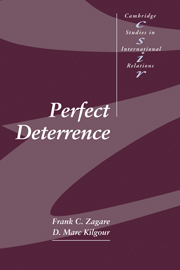4 - Generalized Mutual Deterrence Game
Published online by Cambridge University Press: 01 October 2009
Summary
This appendix contains the detailed analysis of the Generalized Mutual Deterrence Game with incomplete information, introduced in chapter 4 and specified in section A1.2. (See also figures 4.1 and A1.3.) Recall that the twelve parameter values satisfy 0 < pA < 1, 0 < pB < 1, aDD− < aCD < aDD+ < aSQ < aDC, and bDD− < bDC < bDD+ < bSQ < bCD. Moreover, player A is Hard, i.e., A's utility for outcome DD is aDD+, with probability pA, and A is Soft, i.e., A's utility for outcome DD is aDD−, with probability 1−pA. Similarly, B is Hard (utility bDD+ for DD) with probability pB, and Soft (utility bDD− for DD) with probability 1−pB.
We are interested only in subgame-perfect equilibria, so we can assume that choices at nodes 3a and 3b are made optimally, according to type. Thus we take A's only strategic variables to be xH and xS for the probabilities that A chooses D at node 1 when Hard and when Soft, respectively. Likewise, B's strategic variables, representing the probability that B chooses D at nodes 2a and 2b, are yH if B is Hard and yS if B is Soft. This produces the game shown in figure A4.1.
- Type
- Chapter
- Information
- Perfect Deterrence , pp. 331 - 338Publisher: Cambridge University PressPrint publication year: 2000



